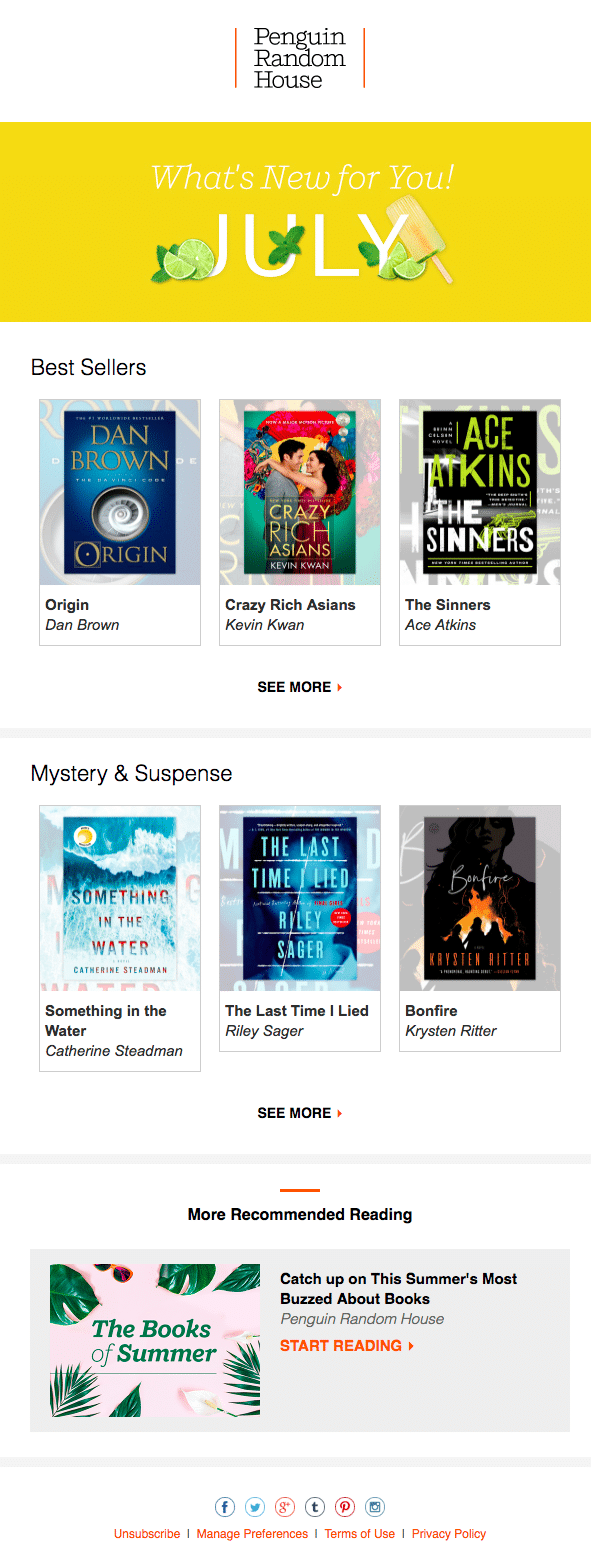Marketers have set a new goal. Creating quality content on a consistent basis is no longer good enough. Now, the focus is on more engaging content. Seventy-three percent of marketers say creating engaging content is their top priority.
More marketers are using email as a vehicle to drive subscribers to content—and it’s working. Marketers, especially those in the media and publishing world, use their contact list to send hyper-targeted messages to their subscribers. It takes some work, but with the help of email campaign automation, marketers can send personalized emails that result in elevated content engagement metrics.
Why personalization matters
Consumers expect relevant content
. The avid outdoorsman with a love of winter camping expects to see specific sleeping bag recommendations for cold climates, how-to articles on setting up a fire when the ground is wet, and video reviews of fan-favorite tents.
Research shows 67% of customers expect this kind of high-level personalization from a brand, and when a brand doesn’t deliver, 42% of consumers get annoyed and 66% of consumers stop buying from the brand. In a nutshell, if you’re not delivering relevant content, you’re losing money.
How to send personalized emails to drive content engagement
Personalized content is important. Message received. But, how specifically are marketers using email to deliver personalized content and move the engagement needle? Great question.
Here’s a look at three actionable ways you can increase content engagement:
1. Send emails based on a subscriber’s self-selected preferences automatically
To send relevant content, you have to know your customers. In the digital age, that means collecting customer data. You want to know what your customers are into. But, how? By using a preference center.
With a preference center, customers can tell you their interests, hobbies, even how often they’d like emails from your brand. Penguin Random House, a publisher and Campaign Monitor customer, asks customers to self-select book genres of interest in its preference center.

Penguin Random House uses the selections made in the preference center to create specific customer segments. In other words, subscribers are divvied up by their interests.
With subscribers in small like-minded groups, Penguin Random House can send content to each group that’s relevant. For example, a subscriber who’s interested in Best Sellers and Mystery & Suspense receives the email below:

You’ll notice that the email above was sent in July. Penguin Random House sends specific book suggestions to readers every month.
Sounds time-intensive, right? Wrong. By using email automation campaigns, Penguin Random House can create these newsletters ahead of time and schedule their delivery.
Campaign Monitor offers segment-triggered automation, so when a customer joins a new segment, say, the biography segment, this action triggers the delivery of an email. (Pretty cool, right?)
The Campaign Monitor website has more information about automated journeys and how segment-triggered emails work.
2. Create a special ‘courses’ to further engage segments
Using a preference center is an effective way to segment contacts and personalize emails. Buzzfeed, another Campaign Monitor customer, uses a preference center much like Penguin Random House.
Subscribers select which category of content they want to receive, and, as a result, get exactly what they want in their inbox. A subscriber who selects the ‘Cooking’ newsletter, for example, gets this content:

However, the publisher goes one step further. Buzzfeed created “guided courses” for certain segments. For example, subscribers on the cooking list are offered a weekly meal prep course. Subscribers in the fitness segment are offered a course on preparing for a 5k run.
The publisher is trying to hyper-segment their list by offering more niche content.
Subscribers interested in the meal prep course receive the email below, which provides an entire week’s worth of meal ideas, complete with a grocery list, schedule, and recipes. Here’s a look:

Essentially, Buzzfeed has segmented its segment. From the cooking segment, the publisher can now pull out another niche group of contacts and offer them strategic content.
Using email automation campaigns, Buzzfeed can create the meal prep course ahead of time and schedule them to deliver on a specific date and time.
3. Send content based on a subscriber’s browsing history
A preference center is a handy data-collecting tool, but there are others. A website tracking tool, for example, that shows you what customers look at on your website is another must-have.
Using Campaign Monitor’s website tracking snippet, you can record a customer’s browsing history and send relevant emails based on his or her activity.
Let’s say you send a subscriber a newsletter. The website tracking tool will record the subscriber’s actions. The subscriber clicks on a celebrity news article in the newsletter and reads the entire article on your blog. Then, he hops to another celebrity news post before taking an online quiz that tells him which celebrity he’s most like. Obviously, he’s interested in celebrity news.
Based on his browsing history, you can send him emails that focus on the latest Kardashian gossip or the most recent marriage scandal to rock Hollywood. You know he’ll love it because he’s read that kind of content before.
Now imagine sending emails like this on a larger scale. Using email automation campaigns, you can.
You can create a dynamic email that changes based on a subscriber’s interests. (Say, what?)
You create one email. Let’s say it’s a newsletter. You want the top piece of content to change based on a subscriber’s preferences. So, the celebrity-loving subscriber sees a juicy love scandal, while the subscriber who can’t get enough reality TV sees a story about a new show starting this fall.
Each subscriber gets content that’s relevant to his or her life.
Showtime, a Campaign Monitor customer, does something similar. The company sent out an email that encourages subscribers to watch certain shows, but the shows in the newsletter aren’t random. All of the shows are relevant to the subscriber, based on what they’ve watched or browsed in the past. The shows are swapped out depending on a subscriber’s interests.

Wrap up
Focusing on personalized content is a solid marketing technique that’s sure to move the engagement needle. Why? You did your homework. You learned about your customers, created relevant content, and sent email automation campaigns to streamline the process. It’s the perfect recipe to increase content engagement.





